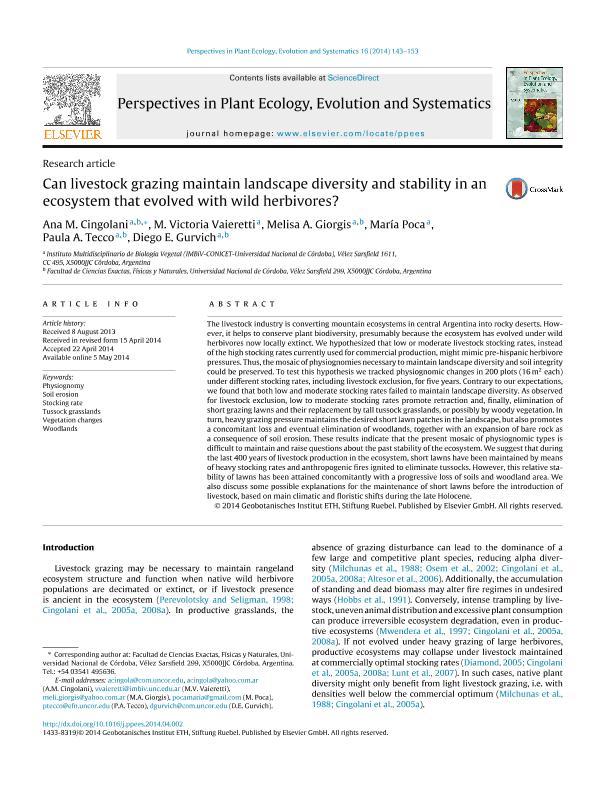Artículo
Can livestock grazing maintain landscape diversity and stability in an ecosystem that evolved with wild herbivores?
Cingolani, Ana María ; Vaieretti, Maria Victoria
; Vaieretti, Maria Victoria ; Giorgis, Melisa Adriana
; Giorgis, Melisa Adriana ; Poca, María
; Poca, María ; Tecco, Paula Andrea
; Tecco, Paula Andrea ; Gurvich, Diego Ezequiel
; Gurvich, Diego Ezequiel
 ; Vaieretti, Maria Victoria
; Vaieretti, Maria Victoria ; Giorgis, Melisa Adriana
; Giorgis, Melisa Adriana ; Poca, María
; Poca, María ; Tecco, Paula Andrea
; Tecco, Paula Andrea ; Gurvich, Diego Ezequiel
; Gurvich, Diego Ezequiel
Fecha de publicación:
06/2014
Editorial:
Elsevier Gmbh
Revista:
Perspectives in Plant Ecology Evolution and Systematics
ISSN:
1433-8319
Idioma:
Inglés
Tipo de recurso:
Artículo publicado
Clasificación temática:
Resumen
The livestock industry is converting mountain ecosystems in central Argentina into rocky deserts. However, it helps to conserve plant biodiversity, presumably because the ecosystem has evolved under wild herbivores now locally extinct. We hypothesized that low or moderate livestock stocking rates, instead of the high stocking rates currently used for commercial production, might mimic pre-hispanic herbivore pressures. Thus, the mosaic of physiognomies necessary to maintain landscape diversity and soil integrity could be preserved. To test this hypothesis we tracked physiognomic changes in 200 plots (16 m2 each) under different stocking rates, including livestock exclusion, for five years. Contrary to our expectations, we found that both low and moderate stocking rates failed to maintain landscape diversity. As observed for livestock exclusion, low to moderate stocking rates promote retraction and, finally, elimination of short grazing lawns and their replacement by tall tussock grasslands, or possibly by woody vegetation. In turn, heavy grazing pressure maintains the desired short lawn patches in the landscape, but also promotes a concomitant loss and eventual elimination of woodlands, together with an expansion of bare rock as a consequence of soil erosion. These results indicate that the present mosaic of physiognomic types is difficult to maintain and raise questions about the past stability of the ecosystem. We suggest that during the last 400 years of livestock production in the ecosystem, short lawns have been maintained by means of heavy stocking rates and anthropogenic fires ignited to eliminate tussocks. However, this relative stability of lawns has been attained concomitantly with a progressive loss of soils and woodland area. We also discuss some possible explanations for the maintenance of short lawns before the introduction of livestock, based on main climatic and floristic shifts during the late Holocene
Palabras clave:
Physiognomy
,
Soil Erosion
,
Stocking Rate
,
Tussock Grasslands
Archivos asociados
Licencia
Identificadores
Colecciones
Articulos(IMBIV)
Articulos de INST.MULTIDISCIPL.DE BIOLOGIA VEGETAL (P)
Articulos de INST.MULTIDISCIPL.DE BIOLOGIA VEGETAL (P)
Citación
Cingolani, Ana María; Vaieretti, Maria Victoria; Giorgis, Melisa Adriana; Poca, María; Tecco, Paula Andrea; et al.; Can livestock grazing maintain landscape diversity and stability in an ecosystem that evolved with wild herbivores?; Elsevier Gmbh; Perspectives in Plant Ecology Evolution and Systematics; 16; 4; 6-2014; 143-153
Compartir
Altmétricas



